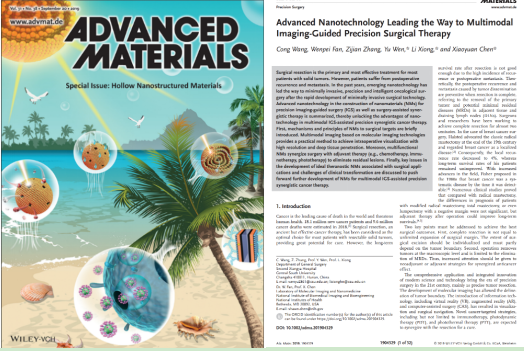On September 19th, the journal Advanced Materials(IF=25.809), an international authoritative journal in the field of nanotechnology, published the cutting edge views of the photodynamic research team of the Department of General Surgery of Second Xiangya Hospital of Central South University (CSU) on the role of nanotechnology in construction of nanomaterials (NMs) for precision imaging-guided surgery (IGS) and surgery-assisted synergistic therapy in the form of Review, with Dr. Wang Cong, Fan Wenpei, and Zhang Zijian from the team as co-first authors of the paper, and Associate Professor Wen Yu, Associate Professor Xiong Li, and Professor Chen Xiaoyuan of the National Institutes of Health (NIH) as co-corresponding authors.

Surgical resection is the primary and most effective treatment for most patients with solid tumors; however, patients suffer from postoperative recurrence and metastasis. How to achieve “complete resection”? At the same time as the precise resection of large tumors occurs, photodynamic therapy (PDT) is expected to achieve the cure for invisible microscopic lesions or tumor cells scattered on the wound surface. As a new type of inspiring diagnosis and treatment, the photodynamic technique has a significant effect on solid tumors and is a new therapy for tumors other than surgery and radiotherapy and chemotherapy. Also, the photodynamic technique is effective for various proliferative diseases such as bacterial diseases and inflammation. Based on years of inspiring diagnosis and digital intelligent surgical research, the PDT research team of the Department of General Surgery of Second Xiangya Hospital has systematically summarized the advanced nanotechnology in the construction of NMs for precision imaging-guided surgery (IGS) and surgery-assisted synergistic therapy, explored the advantages and great prospects of nanotechnology in multimodal IGS-assisted precision synergistic cancer therapy, indicated that the tumor treatment by combination of advanced materials and precision imaging-guided surgery would be a new direction of tumor surgery research.
The PDT research team of the Department of General Surgery of the Second Xiangya Hospital has carried out many clinical and basic researches on PDT for digestive tract cancer, inflammatory bowel disease and breast cancer in recent years. The research team has won 5 national natural science funds and 10 provincial and ministerial level projects, declared the second prize of Hunan Medical Science and Technology Award, and published 17 SCI papers. The team established the first sound PDT research team in general surgery in the province, and cultivated a complete discipline echelon.
Source: Second Xiangya Hospital











